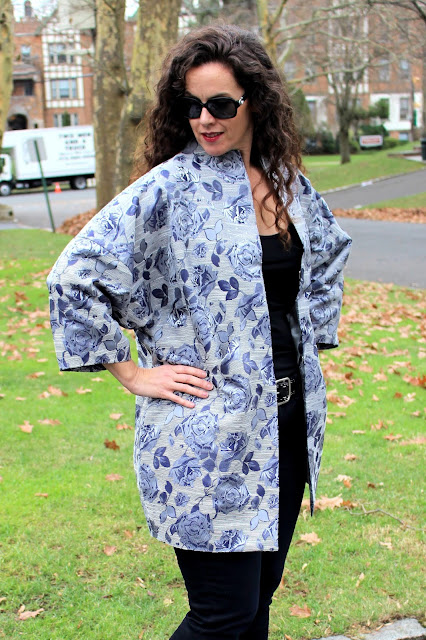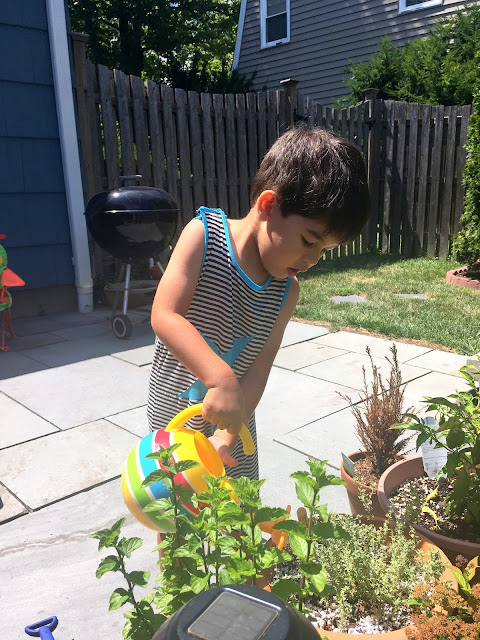Finally a few pictures of my trench coat!
I began this trench waaaaay back around Thanksgiving. For some unknown reason, I always start a major project at Thanksgiving thinking that I will be finished by Christmas. It never happens. I finished the final touches around mid-February and have been wearing this coat non-stop since the weather turned warmer and rainier.
The pattern for this cute trench is
Lekala #4176, descriptively named "Raincoat." It has the features of a typical trench coat, but with a fun little extra at the back.
In this fabric - raspberry colored cotton/nylon water resistant sateen that I picked up at the Paron Fabric closing sale - there would be no mistaking this for menswear. However, I love feminine details added to more traditional, staid menswear styles, like the trench coat.
This was my first time sewing a
Lekala pattern. If you are not familiar with the brand, they use software to create a custom pdf pattern using your measurements and any of their hundreds of designs. At less than $3 (seam allowances $.50 extra) trying Lekala was a low risk proposition. And I was curious to know how well a pattern made to my measurements would fit vs the usual number of changes that I would expect to make to a standard coat pattern (ie.: FBA, lengthening above and below the waist, narrow back, narrow neck, grading out at the hip, changes to the armscye and sleeve, and lengthening the sleeve).
The answer: the fit was pretty darned good "out of the envelope." The only changes that I made to my muslin was that I needed to raise the waist by about 1", narrow the back slightly at the princess seams and take in the waist at the side seams by maybe 1/4". Other than that, the fit was pretty spot on. The shoulder, armscye and sleeve, which are normally challenging areas for me all fit well with no changes. The bust, too, fits my figure well and it was great to not have to do all my usual changes which add time onto my projects. In the past I've been guilty of over fitting coats and jackets, which I think I avoided here by getting a pretty good fit out of the gate.
Now, I don't mean to imply that everything was perfect. There were a few issues with the pattern and instructions.
First, the instructions. I would give the Lekala instructions a solid rating of "if you sew BurdaStyle patterns, then you'll be ok." Better yet, if you regard them as a suggested order of construction rather than actual instructions, you'll be just fine. I would not, for example, try to sew the welt pockets using the instructions provided, but would use the ones that I am comfortable with from other projects or tutorials. The same goes for doing the lining and lapels. There are no pictures and there were some translation issues such as referring to decorative/fixing stitches (ie: basting stitches) and references to the back "yolk" piece. That said, from what I understand, Lekala has improved the instructions on their newer patterns. So my comments pertain to the older pattern instructions.
 |
| Smart money says use your own preferred welt instructions. |
Next, the pattern. The pattern pieces went together just fine. However, the real problem that would affect a less experienced sewist is that there were missing (undrafted?) or slightly off pattern pieces. For example, there
were facing pieces for the back neck and button/buttonhole bands down the front. However, there
were not lining pieces that matched up with them. The back lining was drafted as all one piece from hem to collar rather than it being drafted to join with the facing. So, I had to alter that piece. And I had to draft a center front lining piece by using the main fabric center front piece and subtracting out the button band/facing.
 |
| Silk charmeuse for the lining from Chic Fabrics |
Most important, the way that the center back piece is drafted, the fashion fabric does not extend underneath the storm flap (yoke), which is not attached to the back piece except at the shoulders and armscye - either it hangs free or you are supposed to stitch the yoke facing to the back piece, which just is not the best idea, I think. If you sewed the pattern as drafted but with the yoke hanging free, there would be nothing but the wrong side of the lining beneath the storm flap. So, I used the back lining piece to extend the back piece up to the collar. Again, this was easy for an experienced sewist, but it might present obstacles for someone less familiar with linings and coat/jacket construction.
 |
I extended the center back pieces so that they would go up to the
collar instead of stopping at the storm flap |
The only other sewing related things to say are:
- I left off the straps and buckles on the sleeves. I didn't think the coat needed that detail
- In the future I would add a buckle or other hardware to the belt
- Almost all of the seams have two rows of topstiching, done with two strands of regular thread (I loathe top stitching thread) in the top and one in the bobbin set to a longer stitch length
- I added a pleat to the center back lining and a jump pleat to the lining at the hem
- I outsourced the buttonholes to Johnathan Embroidery.
- I did not add a button and button hole to the stormflap
 |
| Pleat |
I took my time sewing this coat little by little as I had so many colds and distractions over the winter. That said, I wasn't angling for perfection (read: please don't examine the aforementioned topstitching too closely).
My thoughts on Lekala are that I would and will sew from their patterns again. In fact, I've purchased a few more patterns to test, this time for dresses and blouses. I don't expect for the fit of any pattern - even one drafted to my measurements - to be perfect from the outset, but if I get a head start on some of my normal changes, it will be a big plus given that my sewing time is limited. So, I'm eager to see if the fit holds up with their more fitted garments. And by the way, Lekala has a large catalog of patterns for women - particularly dresses, shirts, skirts and jackets/coats, and seem to add new ones regularly with updated details that reflect current trends. I also like that you can create an account to save your custom measurements and add patterns to your wish list. I found their check out easy, the processing time very quick and the price of their patterns was rock bottom.
The shortcomings with my one experience with Lekala so far were as I mentioned above. So, my assessment is that Lekala is for those who have a good understanding of garment construction and don't solely rely on pattern instructions.
Anyway, I'm still really thrilled with my new trench and it's color, which I think suits me. I don't like tan and taupe shades on me, and a bright coat is the perfect antidote to a rainy day. This coat could be seen as emblematic of my sewing philosophy. A trench coat is a wardrobe need, but why would I sew a basic when I could truly make it fabulous. Frosting! Truly, I am not into sewing cake.
Here are some final pics.



















































